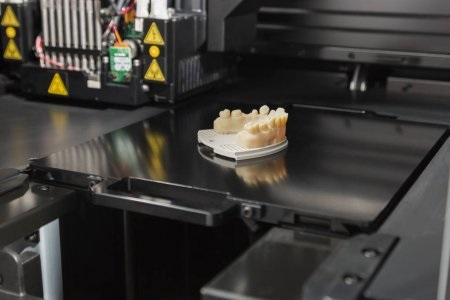3D Printing in Dentistry
What is 3D Printing?
You’ve almost certainly heard of 3D printing. 3D printing is a market-disrupting technology with numerous applications. Aerospace, art, defense, home-building, and more all have major benefits from the use of 3D printing technology. The advantages come from shorter design times, lower customization times, and cheaper, easier, creation of goods. Using CAD (computer aided design) to build something takes less time than building real models, and the materials for 3d printing are much cheaper than custom-ordering special parts, materials, and supplies. Other names for 3D printing are additive manufacturing (AM) and rapid prototyping.
3D printers work by layering chemicals one on top of the other in a specified pattern. As the layers build up, the 3D structure forms, and the printing job is completed.
Printing 3D models with CAD technology is a rapidly-expanding industry. With growth each year in the double digits, the industry is predicted to be worth about 10 billion dollars by the year 2030.
The medical industry stands to benefit (and already is) from the use of 3D printing. Small parts that might take weeks to arrive via custom order can be printed in a few hours. Surgeons can 3D print custom items and design them themselves. This cuts out expensive middlemen and makes it much easier to get items customized with near-perfect exactitude.
For the dental world, 3D printing is a boon to prosthesis and surgery. In the past, a dentist would have to make a mold or cast of a patient’s mouth. Then that model would be sent to a lab for construction. When construction was complete, the model of whatever part/prosthesis was built would be sent back to the dental office for surgical use. This old method had little way for the patient to ensure that the part was exactly correct, and often post-building customization was necessary. The process could also take weeks. With 3D printing, the part can be made exactly according to specifications by the dentist — on the same day.
How is 3D Printing Used in Dentistry?
With the use of CAD and CAM (computer aided modeling) technologies, dentists can make exact diagrams of the parts they need for 3D printing. Not only does this result in more accurate prosthesis, but also in shorter build times faster surgical procedures.
So, in general, 3D printing aids in faster, better, cheaper prosthesis designs. What kind of 3D printing is being used in dentistry now and what does its future look like?
Current Uses of 3D Printing in Dentistry
Cost-saving
A clinic-ready 3D printer for a medical office costs around 4000 dollars. 3D printing materials are cheap, and a model can be made for as little as 20 dollars. The cost saving techniques are obvious, especially considering that an outside lab-made model can cost hundreds or thousands of dollars.
Printed Items
There’s a wide variety of 3D-printed items being used in dentistry presently. Here are a few:
- Orthodontic aligners
- Custom Trays
- Occlusal Guards (for protecting the teeth from clenching/grinding at night)
- Models for study
- Temporary crowns and bridges
- Denture components (base plates, wax rims, etc.)
- Dental prosthesis
Read more in-depth information about 3D printing in dentistry here.
What Does the Future of 3D Printing Hold for Dentistry?
Additive manufacturing is ever getting cheaper and more commonplace. Besides expecting to see more of it, and fewer costs, people can expect higher-quality 3D-printed goods and even more precision.
The technology holds amazing capability for even more uses in dentistry.
Permanent Prosthetics
As the materials that can be 3D-printed increase in variety, so do the uses of this technology. Resins, plastics, metals, and more are already in use. Expect better, more specific materials that can be used specifically in prosthetics to become more commonplace. Dentists will be able to make permanent bridges, crowns, and even false teeth using 3D printing technologies.
Teledentistry
As we have mentioned before, teledentistry (remote dentistry using technology) is a relatively new technology. Teledentistry is the use of technology to provide oral health advice and care to patients in different locations from dentists. In the future, patients may be able to use home equipment, maybe even the cameras on their computers or phones to scan their mouths and thus aid a dentist in making 3D models. These models can be used for prosthetics, components for dentures/braces, mouth guards, or even custom toothbrushes.
Faster, Cheaper Manufacturing — and Higher Quality
Additive manufacturing already helps model and make materials for dentistry more quickly and cheaply. In the future, we can expect this process to be streamlined. As 3D materials that can be printed gain even more precision and durability, they may become better than traditional dental supplies. It’s possible that even pills, gels, and medicines can be 3d printed in the future.
As mouth-scanning and modeling technology also improves, the design process for 3D-printed parts also speeds up. Patients may be looking at 3D-printed items being designed, printed, and delivered in the process of one day or even less.
Learning More About 3D Printing and the Cutting Edge of Dentistry
If you are curious about 3D printing in dentistry, feel free to contact us with any questions or queries. Our staff will be happy to help you with any questions about technology in dentistry. Our award-winning dentist Fort-Worth area dentist, Dr. Ku, is also happy to help with any dental issues you may have. Schedule a check-up, get something serious looked at, or handle a dental emergency with us.






